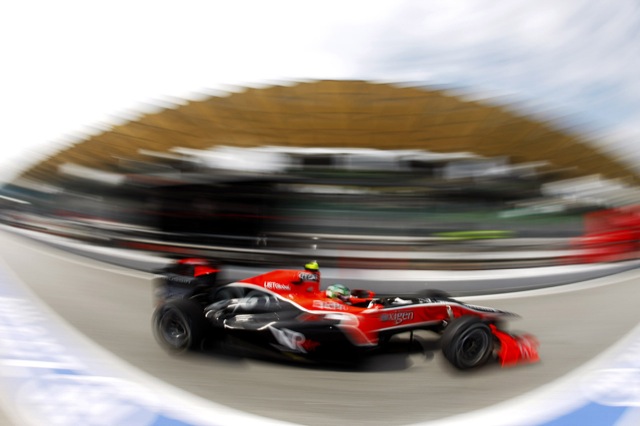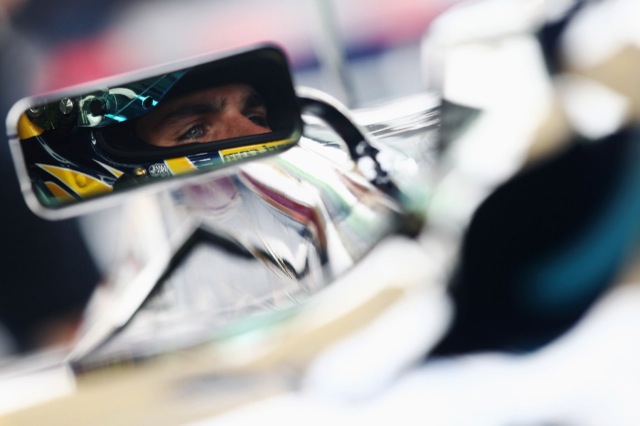Toyota’s livery is often the centre of many jokes in the media, primarily the blogs and offbeat sites, but also occasionally in the mainstream as well. In the eyes of the motor company’s executives, it is almost certainly a well-sculptured brand identity exercise. But to those who have to watch the cars pound around the circuit year after year, the red and white can get a little tedious. And just to prove the point, let’s take a look at all nine Toyota Formula One cars…
Toyota TF101
Test Car
Toyota’s development car – also called the AM01 – never raced, but it was used to evaluate drivers for the debut of the team in Formula One in 2002. Out of all the following liveries, this test car was probably the most distinctive. Bland and mundane, yes. But at least it stands out among the others.


Toyota TF102
2002
The first sight of Toyota’s splash livery. Predominantly white with red diagonal distressed stripes; one across the nose, and two each symmetrically spreading up past the centre monocoque and over the exhausts. Note the front wing end-plates. The left one is white, the right one is red (it’s more obvious in the TF103 pictures).


Toyota TF103
2003
The only difference I can see is the lack of red circle in the middle of the drivers headrest. I always presumed it symbolised the Nisshoki (the flag of Japan), and it made a return the following year.


Toyota TF104
2004
Only a subtle change for 2004; the return of the Nisshoki and a slight alteration in the edging and styling of the stripes. Also, the mirrors matched the front wing end-plates; red mirror on the right, white on the left.


Toyota TF105
2005
The 2005 car featured more red over the sidepods, but because of this it lost its striped appearance.


Toyota TF106
2006
The stripe over the nose has been narrowed. And I think that is about it for changes in 2006.



Toyota TF107
2007
The nose stripe was widened for 2007, and with added sponsorship from Kingfisher, the sidepods took on a slightly more formal look. Also, the front wing end-plates are now both the same colour – white.



Toyota TF108
2008
2008 marked the biggest change in Toyota’s livery, with the edging of the stripes changing to a more ‘dripped’ look as opposed to the previous ‘splashed’. The front element in the front wing has also been changed to white – an improvement in my opinion.


Toyota TF109
2009
The 2008 trend didn’t last long though as 2009 saw a return to the diagonal stripe, although the splashes over the sidepods are no longer symmetrical, instead they have touches of white streaked around to see a return of the distressed look.



If I had to choose a favourite, it would be difficult to decide based on livery alone. Bringing the shape, style and flow of the car into it makes it easier though; it’s between the TF106 and the TF108, and as the 108 performed better, I guess it’s probably the better of the eight that raced. In my mind, anyway.
So should Toyota continue with the red and white splash, or should they do something radical next year and change their livery? What do you think? Do you like it? Is it still fresh to you? Or is it dated and boring?
Photos © Toyota Motorsport Gmbh


















[…] Toyota’s Livery Development: 2002 – 2009 – BlogF1The people designing Toyota's livery have been made to work overtime over the years. […]
Thanks Ollie, was having trouble sleeping…
All part of the service, Keith. 😀
interesting :-s
Any ideas on how much they spend on liveries?
I have no idea, but I wouldn’t have thought it would be that much. With the manufacturers, the base colours are going to represent the parent company (yellow Renault, red Ferrari, white and blue BMW…) and for the privateers, the principal sponsor will undoubtedly have a say (gold/yellow Benson & Hedges Jordan, white and red Marlboro McLaren, black and gold JPS Lotus…)
I would imagine the teams hire/outsource a graphic designer or company who will put all the sponsor’s logos together and come up with a package for the teams. And I would also assume the team apply the base colour themselves as there are quite a few parts that need painting – all the spare bodywork pieces have to painted too, just in case. All the other details are just stickers, I believe. Stickers that are very carefully applied.
It’s a good question B, I’ll keep my ear to the ground in case something of interest turns up. If you want to see a car being prepared, I have a post on Red Bull’s Race For Life charity ‘face’ livery (from 2007) with a few photos of the team applying lots of stickers to it: Red Bull ‘Faces For Charity’ Livery
Considering all the donations and the fact it still had to be designed and prepared, the ‘Faces’ livery is probably the most expensive ever. Especially when you consider that it was only used for one race!
Wow that was some meticulous livery work done to the Red Bull! lol
Thanks a lot for the reply Oliver.
Jordan used to outsource painting of the cars to a local paint shop as part of an in-kind trade deal. Nowadays, it wouldn’t surprise me if it was all done in-house for the reasons Ollie cited.
[…] Toyota’s Livery Development: 2002 – 2009 […]
I don’t understand the fuss about Toyota livery. It seems obvious to me that Toyota use the red/white theme as a statement of nationality, rather as Force India obviously feels bound to some extent by the colours of the Indian flag. If nothing else, this harks back to the days when each nation had a racing colour – note that Ferrari continues with its use of red as a salute to those days (it’s not Ferrari red, it’s Italian red). And, if you ask me, the British cars would look a whole lot better if they went back to British Racing Green.
To bring it up to date, however, Toyota are wise in sticking to a basic colour scheme, having successfully established a “look” for their F1 cars in quite a short time. Let’s face it, none of us has any problems in identifying the Toyotas in a race whereas in 2008 there was often confusion between the McLarens and Force Indias. If the red/white stripe theme is boring (and I don’t accept that it is), that is a good thing – it’s more important that the car performs well and is recognisable than that everyone thinks its livery is sexy.
It’s a matter of taste anyway. Take the Toro Rosso, for instance – I think its cartoonish red bull on a dark blue background is awful but have seen plenty of comments from those who love it. This is F1, remember, and no place for silly go-faster, look-at-me flashiness. If a livery establishes identity without shouting to the rooftops, that is all that is required of it.
Yes, i’m still hoping Guinness would sponsor a team and bring back the black and gold livery. And it wouldn’t hurt if they had free samples at the races.
Huh?! Half of F1 is about glamour, money, and “look-at-me flashiness.” Look at the team’s motorhomes. Look at the flag girls on the grid. Look at the celebrity guests in the garages. Look at anything in Monaco during the F1 weekend.
I bet half the audience (including me, a fan for 20+ years) would stop watching F1 if you took all the flashiness away from it. And that includes the cars’ livery, the drivers’ uniforms, and their diamond-studded helmets too. It can’t be all seriousness.
And let’s not forget DC’s appearance on the podium at Monaco in a Superman cape, Bem. But, in a way, you’re making my point for me – the flash and glitz is there in F1, yes, but note that it’s the most serious teams that do the winning. And, judging by their obstinately unchanging livery, Toyota stand some chance of eventually making it to the top step of the podium. 😉
[…] the popularity of the Toyota Livery Development post from Thursday last week, and also given the Sidepodcast have made a request, here’s a quick […]
[…] Ollie has written the second of his livery development posts. We already saw the way Toyota hasn’t changed a bit, and now it’s a look at how the Renault turned from a respectable blue to a blinding […]
2005 brought also the mirrors to “all white” on both sides I think :).
Somehow I would have prefered a livery closer to the GT-ONE in it’s design but on the other hand, that would have brought up some problems to differentiate Ferrari and Toyota. And we already got more than ebough red on Formula 1 cars. Kill me for it, but the best looking livery of all Toyotas’ in my opinion has the TF109, even if I liked the TF105 shape most. And it also was very fast, they would have finished 3rd in constructors championship without ferrari racing in Indy that year.
So yes… it would have been great to see something new on the TF109 but… we all can see a Toyota F1 now without having to think “Ergh… which car was that…?!”
[…] a great deal on their graphic designers who come up with the liveries. Perhaps these were due to Toyota never really making any substantial changes to their liveries and Renault changing, but for the worse each and every time. However, BAR spent a […]
[…] a great deal on their graphic designers who come up with the liveries. Perhaps these were due to Toyota never really making any substantial changes to their liveries and Renault changing, but for the worse each and every time. However, BAR spent a […]
From the Toyota website:
That’s quite an interesting explanation of what one would normally think is a dash of red on white!
The thing is that I could probably spot the Toyota without the livery because it always seems to be one step behind the other teams in terms of aero shape 🙁
Still, distinctiveness is good. In this case it also reflects the unchanging nature of the team; every other team seems to adapt more, so it is only natural that they change paint scheme design more (even Ferrari does, though it’s more the shade and pattern that changes than the basic scheme).